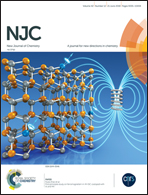Highly dispersed, ultra-small and noble metal-free Cu nanodots supported on porous SiO2 and their excellent catalytic hydrogenation of dimethyl oxalate to methyl glycolate†
Abstract
The production of methyl glycolate (MG) from the catalytic hydrogenation of dimethyl oxalate (DMO) derived from syngas (H2 + CO) as an environmentally benign and economical route has attracted tremendous interest in the modern chemical industry. Silica-supported noble and transition metal elements have been employed as efficient catalyst materials for this reaction. In this paper, we used a novel, highly efficient and eco-friendly sonochemical approach to synthesize noble metal-free, ultra-small and highly dispersed Cu nanodots wrapped on porous SiO2 catalysts. The hydrothermal method as a well-known conventional approach is used to synthesize the same catalyst of Cu/SiO2. The synthesized catalysts were exposed to the industrially relevant vapor-phase hydrogenation reaction of dimethyl oxalate, and then the calcined, reduced and spent catalysts were fully characterized using XRD, TEM, HR-TEM, N2 physical adsorption, FTIR, XPS, Cu-LMM and H2-TPR. Notably, the obtained results confirmed that the sonochemically synthesized noble metal-free Cu/SiO2 catalyst displayed remarkably high MG selectivity of 94% and a turnover frequency (TOF) of 5.08 h−1 compared with 81% MG selectivity and 3.45 h−1 TOF for the hydrothermally synthesized catalyst. These results could be attributed to the synergistic and high value of the Cu+/(Cu+ + Cu0) ratio for the synthesized catalyst and the high dispersion and surface area of the nanoparticles. Our ultrasonication technique holds promise for the synthesis of highly dispersed and efficient heterogeneous catalytic materials in aqueous medium with a short reaction time.



 Please wait while we load your content...
Please wait while we load your content...